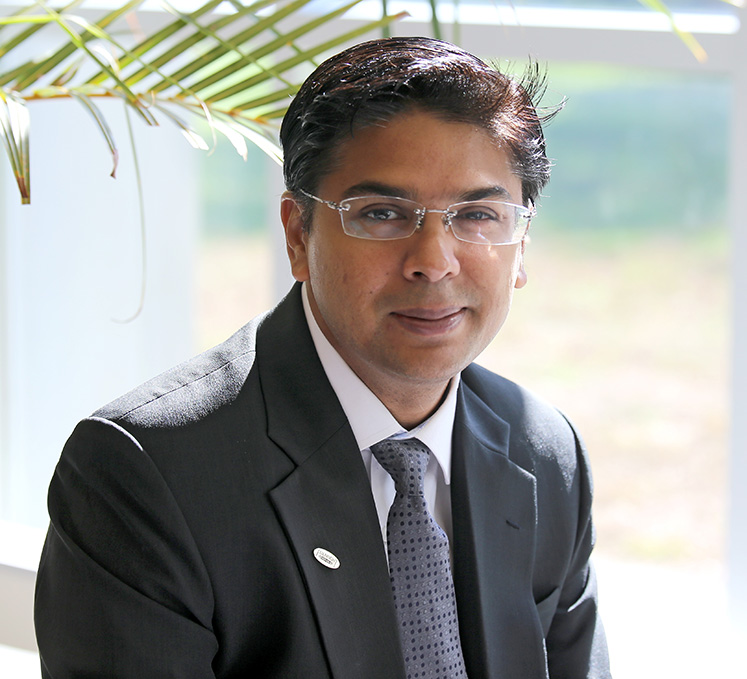Fulbright teacher finds creative ways to convey science
Dr. Muhammad Nazir Bin Amir blends science and the arts to teach academically at-risk students in Singapore
Science and the Arts are often viewed as two contrasting subject areas with little in common, but Fulbright teacher Dr. Muhammad Nazir Bin Amir blends both in the form of design-based projects as a way to teach science to academically at-risk students in Singapore. Nazir has been studying at the School of Education as part of the Fulbright Distinguished Awards in Teaching Program, work that wraps up this week.
Nazir, who has about 14 years of teaching experience, began his teaching career as a relief teacher while waiting to start his masters degree in engineering. During this time, Nazir noticed a considerable number of academically at-risk students in his classes were under-performing in science and mathematics. He observed how they were struggling to understand abstract scientific concepts because the prescribed lessons did not cater to a range of different learning styles and lacked factors that would motivate them. Seeing this, he was inspired to join teaching and undertake research to improve the way science was taught for these students. Nazir wanted to teach in a way that would instill in these students with a love for learning, particularly in STEM (Science, Technology, Engineering & Mathematics) subjects, such as science and mathematics.
Nazir discovered that a way to foster understanding and creativity in science amongst these students would be to capitalize on their strengths in the Arts. Through classroom research, Nazir found that his students became motivated to learn concepts in science, and showcase their creativity at the same time, when they were given opportunities to incorporate knowledge and skills gained from arts and crafts such as designing, crafting, sketching, and coloring. Nazir stated that this method capitalizes on their interests which motivated them to appreciate the academic content not just in science, but also other subjects. Furthermore, by giving them the freedom to come up with toy designs that work on a variety of physics principles, students are provided with avenues to showcase their creative potential. An example of this is a centripetal toy puzzle project that Nazir has his students design and make in Design & Technology (D&T) lessons. Students internalize the concept of centripetal force, while learning design principles and skills in using tools that are available in a technical workshop. Students enjoy making such toys and realize that science can be so much fun!
Such projects exemplify the RAP (Relevant, Appealing and Personal) pedagogical guideline that Nazir developed from his classroom research, which came about as part of his doctoral studies. The RAP pedagogical approach became the foundation of a project-based science curriculum Nazir developed for academically at-risk students in his school, in view of helping them succeed in their academic subjects. One such project is a cotton candy machine made from simple household items. Students get excited learning concepts related to thermal physics, whilst making candy floss in science lessons. Several other projects in the curriculum adopt a multi-disciplinary approach so that students are able to see the relevance of learning academic content across subjects, such as a values-driven multi-disciplinary ‘Toy Story-Telling Project’, which has been running since 2005. In this project, Nazir gets his students to design and make simple toys in support of telling classic fairytale stories to underprivileged children in orphanages and in a school for mentally disabled children. Through such an approach, his students are able to design toys that make use of scientific principles: a combination of a pulley and magnet in getting a prince up Rapunzel’s tower. School values such as respect, responsibility, resourcefulness, and resilience are consciously reinforced throughout all projects. In addition, values such as compassion for their local community are enforced when students present their self-made toys to under-privileged and intellectually disabled children, deepening their sense of empathy.
Nazir’s enthusiasm in wanting to help his students is evident in the way he wants them to view school. He wants them to “think of school as a place to enjoy learning” and does so by creatively weaving in content with RAP-infused lessons to keep them engaged.
Being in the Fulbright program here at IU, Nazir explored how ideas gained from fun STEAM (Science, Technology, Engineering, Art, and Mathematics) activities practiced in U.S. educational institutions can enhance the RAP pedagogical approach to further motivate academically at-risk students in Singapore. During his time in the States, Nazir has shared his teaching methods with educators and students in IU, along with twenty other Fulbright educators from around the world. He also gained new ideas to share with his colleagues in Singapore. Over the past semester, Nazir attended the Makevention and Indiana Toy & Comic Expo in Bloomington, the California STEM symposium in Anaheim, and he visited NASA’s Kennedy Space Centre in Cape Canaveral. These events, as well as local and inter-state school visits, attending seminars and auditing classes, has helped Nazir gain a plethora of new ideas to bring back to his colleagues and students. Nazir is passionate about his role as an educator and has made the most out of his Fulbright experience.
The Fulbright Program is the flagship international educational exchange program sponsored by the U.S. government and is designed to increase mutual understanding between the people of the United States and the people of other countries. The primary source of funding for the Fulbright Program is an annual appropriation made by the U.S. Congress to the U.S. Department of State’s Bureau of Educational and Cultural Affairs.
Since its establishment in 1946 under legislation introduced by the late U.S. Senator J. William Fulbright of Arkansas, the Fulbright Program has given approximately 360,000 students, scholars, teachers, artists, and scientists the opportunity to study, teach and conduct research, exchange ideas and contribute to finding solutions to shared international concerns.
 Muhammad Nazir Bin Amir
Muhammad Nazir Bin Amir